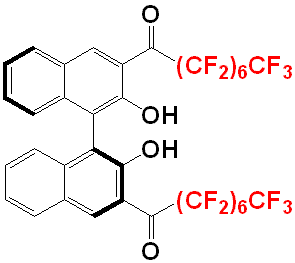 |
| The Organic, the Aqueous, and the Fluorous phasesin their Mexican Stand-Off. Taken from [1]. |
‘Every
gun makes its own tune.’
– The Man
with No Name (Clint Eastwood), in ‘The Good, The Bad And The Ugly’.
Chemistry, like life, is dictated by the golden rule 'like
dissolves like'. Just like a Western film - the showdown is always between a
good guy and a bad guy, right? But then there is the great Sergio Leone, who
shows that human nature is not that simple (and Eastwood makes his day in this
way). There can be 'The Good, The Bad, and The Ugly', and in chemistry there can
be someone else who doesn't want to mend any fences with neither the greasy
organic nor the watery aqueous. That, has something to do with a guy called
'Fluorine'.
 |
| A CH4 Molecule. Taken from [2]. |
 |
| A CF4 molecule. Taken from [3]. |
Fluorine is always special. It ranks the first in
electronegativity (a really electron density bully here), and its size is huge.
4 small hydrogen atoms surround a big carbon atom to form methane (CH4),
but when the hydrogen is swapped as fluorine, the resulting CF4 becomes 4 huge
fluorine atoms burying 1 skinny
poor carbon atom. If you imagine you have a long carbon
chains with all fluorines substituted on it - the result can be said as a 'fluorine
blanket'.
That leads us to a new concept known as 'Fluorous'. 'Fluorous',
to start with, is related to fluorine.
Yet to understand how we can get something from this, we have to be careful about the meaning. A compound with fluorine atoms on
it does not necessarily mean it is 'fluorous', as 'fluorous' takes a rather narrow definition.
First, you have to have a lot of fluorine atoms in a compound to be fluorous
(the current understanding is that the fluorine content should contribute to at
least 60% of the total molecular weight1), and second, the fluorine
atoms have to be closely packed on the organic molecule, not dispersed throughout
a fatty organic compound with a large molecular weight. If these 2 criteria can
be fulfilled, when you dissolve a fluorous compound or solvent into an organic
phase, even though it is non-polar (means it hates water), it can still be separated
into 2 phases, and so a fluorous-organic bi-phase can be established. This is
great because you can start to engineer novel concepts in reaction design and
catalysis, and this should simplify separation and purification procedures.
This time, I will share with you 2 pieces of great work that
is related to fluorous chemistry.
27/03/2015
Reference:
1. http://www.fluorous.com/journal/?paged=65
2. http://commons.wikimedia.org/wiki/File:Methane-3D-space-filling.png
3. http://commons.wikimedia.org/wiki/File:Tetrafluoromethane-3D-vdW.png
4. I. T. Horváth, J. Rábai , Science, 1994, 266, 5182, 72-75.
5. For those organic compounds which have a fluorine content of more than 60%, they are specifically known as ‘heavy’ fluorous compound. There are also ‘light’ fluorous compounds (which has <40% Fluorine by weight, see Handbook of Fluorous Chemistry, Chapter 8 and references cited therein). In my following 2 articles, the term ‘fluorous’ means ‘heavy’ fluorous compounds.






